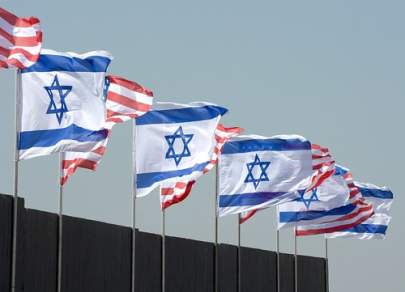Civilization under Attack
Civilization under Attack
By ASCF Sr. Fellow, Alan Dowd

November 2023—The previous issue discussed what the Hamas-Iran axis unleashed upon Israel on October 7. In this issue, we look at how and why Iran wages its war on civilization—and how America and Israel are working together to fight this common enemy.
Death
As the 19th century gave way to the 20th, Leo Tolstoy called the then-stateless Jewish nation “the pioneer of civilization.” Long before Russia’s pogroms or Hitler’s Holocaust or Hamas’s mass-murder spree, Tolstoy wrote: “He whom neither slaughter nor torture of thousands of years could destroy, he whom neither sword nor inquisition was able to wipe off the face of the earth…such a nation cannot be destroyed.”
There is hope in these grim and poignant words, but the terror masters in Tehran don’t read Tolstoy.
Hamas carried out the October 7 attacks, but it was Iran that pulled the strings. Iran’s terrorist tyranny was intimately involved in planning and unleashing the October 7 pogrom. That’s not the opinion of Israeli politicians or an intelligence assessment from Mossad; it’s a statement of
fact smugly revealed by senior members of Hamas.
Iran’s proxies—Hamas, Hezbollah, Islamic Jihad, the Houthis of Yemen—are Iran’s arsenal. As the Foundation for Defense of Democracies details, Iran bankrolls, trains and arms no less than 19 terror groups operating on and/or within Israel’s borders. Iran’s arsenal of terrorist proxies is pointed at Israel, with the ultimate goal of erasing Israel: “We will not back off from the annihilation of Israel,” Iranian Gen. Abolfazl Shekarchi said in 2021.
The enemy described here—Israel’s enemy—is America’s enemy. The names and starting points may differ—Hamas, Hezbollah, PLO, Black September, Islamic Jihad, Islamic Resistance, AlQaeda, AQI, ISIS, Al-Shabaab, Boko Haram—but the tactics and targets and goals are the same. Whether in Munich or Mogadishu or Manhattan, Tanzania or Tehran, Kenya or Khobar Towers, the Gulf of Aden or the Achille Lauro, Beirut or Boston, Sderot or South America, our common enemy “loves death,” as the authors of jihadism have taught us. Our common enemy demands sameness and submission, conformity and control. Our common enemy seeks nothing less than our destruction. Indeed, even as Iranian-backed terrorists swarm and siege Israel, Iranian backed militias are pelting U.S. troops in the region with drones and rockets.
The reason: America and Israel stand for political freedom, religious freedom, reason and the rule of law—and stand in the way of Iran’s terrorist tyranny.
“Israel and America may be thousands of miles apart, but we are philosophical neighbors sharing a strong commitment to democracy and the rule of law,” as President Ronald Reagan observed. “No people have fought longer, struggled harder or sacrificed more…to live in freedom.
Reagan knew well Israel’s history—her captivity and hardship, her liberation, her rise and fall, her diaspora and near-disappearance under Hitler, her willingness to compromise and live alongside Arab neighbors, her war for independence when those neighbors rejected the open hand of compromise, her struggle for survival ever since, and how America has aided in that struggle.
Life
Fifty autumns ago, as in the autumn of 2023, Israel was fighting for survival. In a surprise attack—timed, like the Hamas onslaught, to coincide with a Jewish holy day—Arab warplanes destroyed much of the Israeli air force on the ground. This erased Israel’s air superiority, which had been so critical to Israel’s 1967 victory. Thus, with a five-to-one edge in armor, Egyptian and Syrian tanks sent Israeli troops reeling. In fact, less than half of the Israeli tanks on the outer defensive perimeter survived. Then with the Soviets airlifting supplies into Egypt, Iraqi troops on the way to support Syria, and Israel’s war cabinet contemplating the nuclear option—America offered a helping hand. Israel needed missilery, warplanes and ammunition. President Richard Nixon’s response was unequivocal: “Send everything that can fly.”
Dubbed “Operation Nickel Grass,” the monthlong U.S. airlift delivered 22,395 tons of war materiel to Israel. “The arrival of tanks and artillery shells enabled us to complete our missions,” recalled Maj. Gen. Itzhak Hoffi, who commanded Israel’s northern front. “For generations to come,” Prime Minister Golda Meir declared after the war, “all will be told of the miracle of the immense planes from the United States bringing in the material that meant life to our people.”
America did much more than simply send ammunition to Israel. America literally stood with Israel in that dark hour and knitted together U.S. and Israeli security: Nixon dispatched two carrier battle groups to the eastern Mediterranean. Then, when the Soviets threatened to drop paratroopers into the Sinai, Washington put U.S. nuclear forces on worldwide alert and raised
the Pentagon’s readiness level to DEFCON 3—an unmistakable message to Moscow that Israel’s security was of vital importance to the United States.
America’s response to the 1973 assault on Israel was proof that America and Israel are bound not just by shared values, but also by shared interests. As Reagan put it, Israel “is an integral part of the Free World...Both a secure state of Israel and a stable Mideast peace are essential to our national interests.
Exclamation Points
In the wake of the Hamas attacks, it appears President Joe Biden is following the example set by Nixon and Reagan.
“Hamas unleashed pure, unadulterated evil in the world,” Biden declared, adding, in an echo of Nixon’s words in 1973: “In Israel, we must make sure that they have what they need to protect their people.”
Published reports indicate Washington “has sent…messages to Hezbollah and Iran through third parties, warning them not to intervene.” Those messages have been underscored by American military muscle:
-Two massive carrier strike groups led by the USS Gerald R. Ford and USS Dwight D. Eisenhower are operating in the region, with the Ford keeping watch in the eastern Mediterranean and the Eisenhower moving through the Mediterranean and then focusing on waters closer to Iran. The Ford and Eisenhower can generate hundreds of strike sorties per day and are supported by an armada of destroyers, cruisers, and submarines capable of conducting missile-defense operations and striking targets across the region. Retired Adm. James Foggo says the armada is “probably more ships than we’ve had in that area since 1993.”
-Amphibious assault and docking ships USS Bataan, USS Mesa Verde and USS Carter Hall—all of which carry the 26th Marine Expeditionary Unit—are in the region.
-Importantly, this coiled snake is now under the command of the U.S. 6th Fleet’s command-and-control ship USS Mount Whitney. Underscoring America’s seriousness and readiness for further escalation on the part of the Iran-Hamas-Hezbollah-Houthi axis, the Pentagon let it be known that Vice Admiral Thomas Ishee, commander of the 6th Fleet, is aboard the Mount Whitney. In other words, in the event of additional U.S. intervention, there will be a steel-strong chain of command. (The phrase “additional U.S. intervention” is used because U.S. assets have already engaged the enemy. Operating somewhere in the Red Sea, the destroyer USS Carney tracked and intercepted missiles targeting Israel fired by Iranian-backed Houthi forces in Yemen.)
-The Pentagon has dispatched a team of military advisers to assist the IDF. The team is led by Marine Corps Lt. Gen. James Glynn, who fought in the brutal street-to-street Battle of Fallujah and later commanded special-operations units in the anti-ISIS campaign.
-The Pentagon also has deployed an undisclosed number of F-15E fighter-bombers, A-10 ground-attack planes and F-16 fighter-bombers to undisclosed bases in the Middle East (likely Jordan and Turkey).
-In addition, the U.S. has rushed Joint Direct Attack Munitions, air-to-ground bombs, 155mm artillery rounds and other ammunition to the IDF, with $14.3 billion more in military aid on the way.
Risk
None of this should come as a surprise. Likely because of 1973, America and Israel have been deepening military-to-military cooperation for decades, especially in recent years.
For instance, Israel in 2019 granted the U.S. access to an airbase—the first American military base on Israeli soil—where U.S. troops are manning missile-defense systems. Indeed, for decades, America and Israel have closely collaborated on missile defense. With U.S. help, Israel has erected the world’s most sophisticated missile-dense system, with multiple layers designed to protect against short-range threats, medium-range rockets and long-range missiles. This system has saved thousands of Israeli lives amidst the wars Iran, Hamas and Hezbollah have launched against Israel.
America and Israel carried out their largest-ever joint exercise in January of this year. No doubt hoping to signal Iran, the massive exercise featured 12 warships (led by the USS George H.W. Bush carrier strike group), more than 140 warplanes (including B-52 bombers, F-35 fighter-bombers,F-15 fighter-bombers, F-16 fighter-bombers, F/A-18 fighter-attack jets, AC-130 ground-attack planes, KC-46 refuelers, AH-64 attack helicopters and MQ-9 UCAVs), 7,500 personnel, and 180,000 pounds of live munitions.
There is risk in all this—in training with Israel and standing with Israel and arming Israel and having Israel’s back—as there was when America rushed to help Israel in 1973, as there was when America recognized Israel just 11 minutes after she declared independence. But there is greater risk in sitting on the sidelines, averting our gaze, and letting the enemies of civilization mutilate and murder a fellow democracy. As Biden reminds us, “When terrorists don’t pay a
price for their terror, when dictators don’t pay a price for their aggression, they cause more chaos and death and more destruction. They keep going, and the cost and the threats to America and to the world keep rising.”











